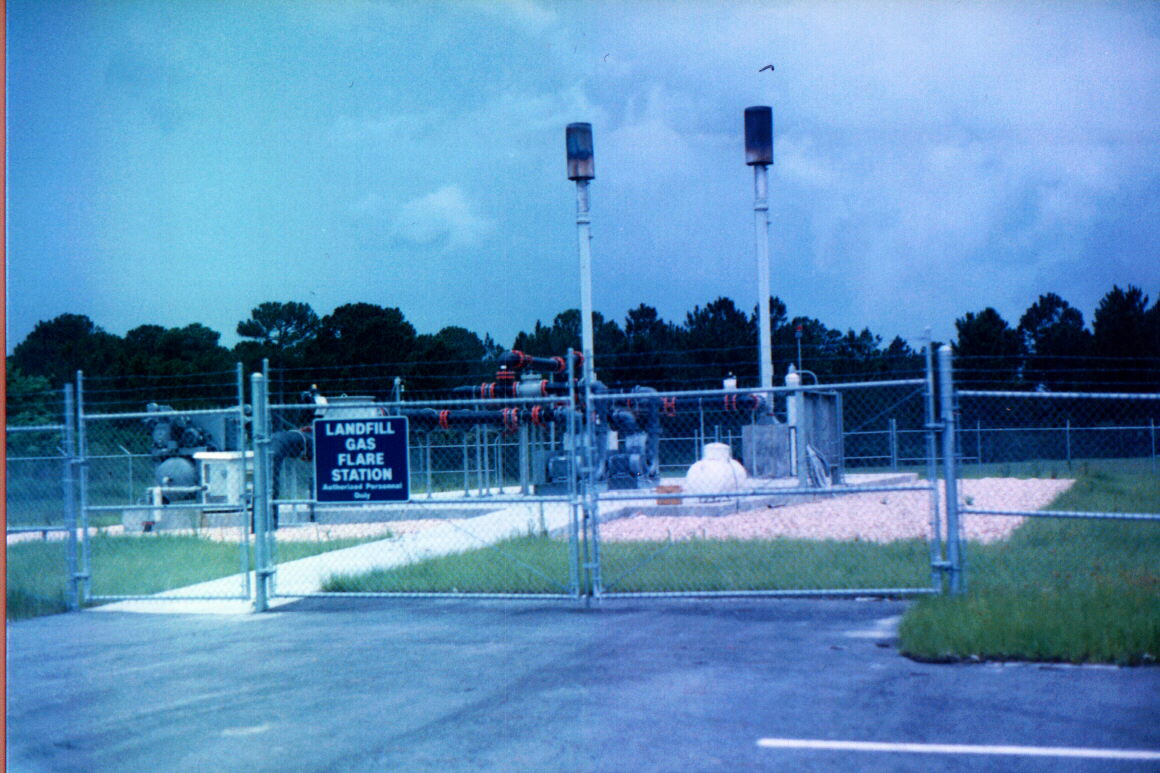Lesson
12: MSW Landfills
Landfill Gas Generation and Control
Read: Text, Chapter 4 (pp. 128-132 & 143-151)
Reactions and Processes
- Biological reactions (microbially mediated)
- Mediate reduction
- Decompose organic waste
- Chemical oxidation/reduction
- Loss or gain of electrons/oxygen
- Gas production, movement, and diffusion
- Bio activity and volatilization of waste constituents produce gas
- Stoichiometric equation for breakdown of organic wastes:

- Degradation rates, slow vs. long
- Significance
- Potential energy recovery of methane
- Methane is a potent greenhouse gas
- Explosive danger - migration to nearby structures
- Health hazards associated with trace gases
- Odor nuisance
- Composition
- Typically 40-60% methane
- Balance primarily carbondioxide
- Higher percetages of methane can result from CO2 absorption by leachate
- Trace gases - volatilization, daughter products,
- Liquid production , movement, and migration - hydraulics
- Leaching and Dissolution of organic & inorganics to the liquid phase
- Contaminant transport (advection, dispersion, diffusion)
- Settlement
- Biological activity
- Height of landfill
- Initial compaction and specific weight
- Characteristics of SW and cover materials
- Age of LF
- Decomposition of SW components
- 90% of settlement occurs in first 5 yrs
Landfill Stabilization
Microbial Metabolism - anaerobic fermentation,
- Steps
- Hydrolysis; substrate converted to a usable form, enzyme mediated
- Conversion of step one products to identifiable intermediates
- Intermediates converted to CO2 and CH4
- Organisms -
- Group which hydrolyzes organic polymers and lipids to building blocks,
fatty acids, amino acids, monosaccharides, etc
- Acidogens or acid formers - ferment hydrolysis products to organic acids,
acetic acid is most common.
- Non-methanogenic, facultative and obligate anaerobic bacteria
- Methanogen or methane formers -convert hydrogen and acetic acid produced
by acidogens to CH4
and CO2, methane
is insoluble
- Can only use certain substrates,
- Synotrophic relationship between methanogens and acidogens
- Acidogens produce hydrogen, formate, acetate
- Methanogens consume hydrogen, hydrogenase, low H2 partial pressures
- Shifts equilibrium to right by removing end products
- Interspecies hydrogen transfer
- Methanogenic bacteria remove compounds that inhibit acidogen growth
- Acid sticking conditions
- Leachate recirculation, buffer addition
Five Phases of a Landfill's Life
- Initial Adjustment -
associated with placement
- Aerobic decomposition until trapped O2 used up
- Accumulation of moisture
- Lag time until favorable stabilization conditions develop
- Transition Phase
- Oxygen depleted and anaerobic conditions develop
- ORP drops to negative values, <300 mV for methanogens
- pH drops due to formation of organic acids
- Acid Phase
- Acidogens kick in, continuous hydrolysis or liquification with fermentation
of SW
- Formation of organic acids and smaller amount of H2
- Heavy metals mobilized due to decrease in pH
- Possible removal of nutrients with leachate stream
- Methane Fermentation Phase
- Methanogens become more predominant
- Methane and acid production procedd simultaneously, acid production rate
is reduced
- pH rises to a more neutral value, carbonate system
- Metals are complexed/preciptated
- Gas production peaks
- BOD, COD, and conductivity of leachate will decrease
- Maturation Phase
- Nutrients limit growth
- Conditions shift from active degradation to relative dormancy
- Gas production drops (doesn’t stop)
- O2 and oxidized species may reappear depending on capping technique
- Humic like substance produced from continuing degradation
Gas Movement
- Convective and diffusive forces drive movement
- May be present in sub-surface outside un-lined landfills
- Control concerns
- Prevent migration
- Relieve pressure build up on LF cap and liner
- Prevent groundwater contamination
- Prevent vegetative damage on surface of LF (methane)
- Energy recovery
- Minimize odor
- Minimize air pollution
- Control techniques
- Passive extraction systems
- Driven by natural pressure gradient within LF
- Active system
- Design a vacuum to direct the flow and control gas flow
Gas
Collection System (GCS)
- Extraction wells
- Vacuum Pumps
- Flare
| Landfill
Gas Flare |
 |
Review: Text, Example Problem
4-4 (pp. 129-130)
Review: Text, Example Problem 4-6 (pp. 146-147)
Review: Text, Example Problem 11-9
Page last updated April 14, 2008 by Dr.
McCreanor
